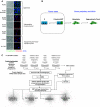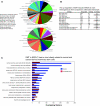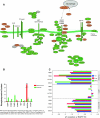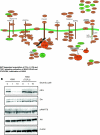A systems view of epithelial-mesenchymal transition signaling states
- PMID: 21194007
- PMCID: PMC3040305
- DOI: 10.1007/s10585-010-9367-3
A systems view of epithelial-mesenchymal transition signaling states
Abstract
Epithelial-mesenchymal transition (EMT) is an important contributor to the invasion and metastasis of epithelial-derived cancers. While considerable effort has focused in the regulators involved in the transition process, we have focused on consequences of EMT to prosurvival signaling. Changes in distinct metastable and 'epigentically-fixed' EMT states were measured by correlation of protein, phosphoprotein, phosphopeptide and RNA transcript abundance. The assembly of 1167 modulated components into functional systems or machines simplified biological understanding and increased prediction confidence highlighting four functional groups: cell adhesion and migration, metabolism, transcription nodes and proliferation/survival networks. A coordinate metabolic reduction in a cluster of 17 free-radical stress pathway components was observed and correlated with reduced glycolytic and increased oxidative phosphorylation enzyme capacity, consistent with reduced cell cycling and reduced need for macromolecular biosynthesis in the mesenchymal state. An attenuation of EGFR autophosphorylation and a switch from autocrine to paracrine-competent EGFR signaling was implicated in the enablement of tumor cell chemotaxis. A similar attenuation of IGF1R, MET and RON signaling with EMT was observed. In contrast, EMT increased prosurvival autocrine IL11/IL6-JAK2-STAT signaling, autocrine fibronectin-integrin α5β1 activation, autocrine Axl/Tyro3/PDGFR/FGFR RTK signaling and autocrine TGFβR signaling. A relatively uniform loss of polarity and cell-cell junction linkages to actin cytoskeleton and intermediate filaments was measured at a systems level. A more heterogeneous gain of ECM remodeling and associated with invasion and migration was observed. Correlation to stem cell, EMT, invasion and metastasis datasets revealed the greatest similarity with normal and cancerous breast stem cell populations, CD49f(hi)/EpCAM(-/lo) and CD44(hi)/CD24(lo), respectively.
Figures






References
-
- Thiery JP, et al. Epithelial-mesenchymal transitions in development and disease. Cell. 2009;139(5):871–890. - PubMed
-
- Yang J, Weinberg RA. Epithelial-mesenchymal transition: at the crossroads of development and tumor metastasis. Dev Cell. 2008;14(6):818–829. - PubMed
-
- Hill R, et al. Selective evolution of stromal mesenchyme with p53 loss in response to epithelial tumorigenesis. Cell. 2005;123(6):1001–1011. - PubMed
-
- Zeisberg EM, et al. Discovery of endothelial to mesenchymal transition as a source for carcinoma-associated fibroblasts. Cancer Res. 2007;67(21):10123–10128. - PubMed
-
- Orimo A, et al. Stromal fibroblasts present in invasive human breast carcinomas promote tumor growth and angiogenesis through elevated SDF-1/CXCL12 secretion. Cell. 2005;121(3):335–348. - PubMed
MeSH terms
Substances
LinkOut - more resources
Full Text Sources
Other Literature Sources
Research Materials
Miscellaneous

